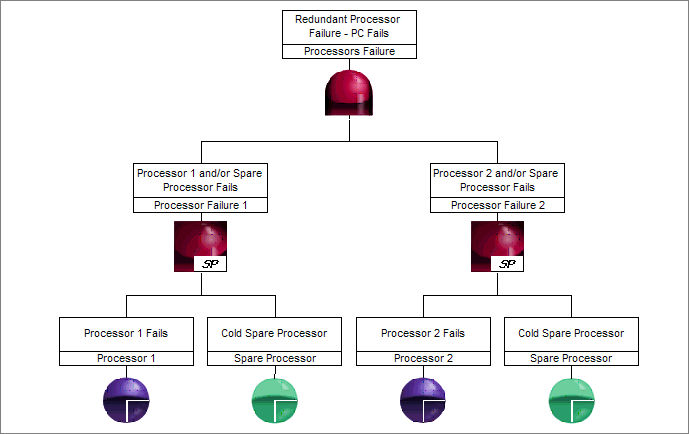Spare Gate
The spare gate is used to model cold, warm, and hot spares in the system. The spare gate is used to indicate that the output occurs if and only if all spare events (inputs) occur.

Spare events are a special event type used to model spare usage in time dependent fault trees. A spare event can be an input to only a spare gate or a functional dependency gate. While spare events are similar to basic events in functionality, they allow only failure rates as inputs to accurately model the temporal behavior. For more information, see Spare Event.

The dormancy factor for the spare event indicates the ratio of the failure rate in the standby mode and the failure rate in the operational mode. A spare event can have a spares pool, which represents the number of identical instances of that spare component (event). For example, if a spares pool of an event is two, there are two identical spare components of that spare event.
All inputs of a spare gate are spare events. A spare gate can have multiple inputs. The first event (left-most event) is known as the primary input, and all other inputs are known as alternative inputs. The primary event is the one that is initially active or powered on, and the alternative inputs are initially in standby mode.
After a failure, the active/powered unit that is the first available spare from left to right will be made active. If all units are failed, then the spare will be considered as failed (output occurred).
Depending on the dormancy factor of spares, spares can fail even in standby mode. The spare gate is flexible and can handle all kinds of spares.
• If all inputs of a spare gate are identical, then it acts like a standard spare gate.
◦ If the dormancy factor is zero, then it cannot fail in the standby mode, and its failure rate in the standby mode is zero. Hence, the spare event is called a cold spare, and the gate is called a cold spare gate. Cold spares are used to model the components that are not powered until needed.
◦ If the dormancy factor is one, then the spare event acts like a hot spare, which is continually powered. Hence, the gate is called a hot spare gate.
◦ If the dormancy factor is between 0 and 1, the spare acts like a warm spare, which is partially powered in the standby mode until it is needed. Hence, the gate is called a warm spare gate.
• The inputs to the spare gate can be non-identical and can have different failure rates and dormancy factors. This allows you to model complex and hybrid spares in an effective manner.
You can rearrange spare events that enter spare gates by clicking on the events and dragging them to new locations.
Summary of Logic: All inputs must be TRUE for the output to be TRUE.
A truth table for the spare gate follows.
A | B | Output |
|---|---|---|
T | T | T |
T | F | F |
F | T | F |
F | F | F |
Example
A computer system has dual redundant processors. Assume that a cold spare can replace either processor when it fails and that this cold spare does not fail before use. Assume also that a switching mechanism failure could possibly prevent the use of the spare.
